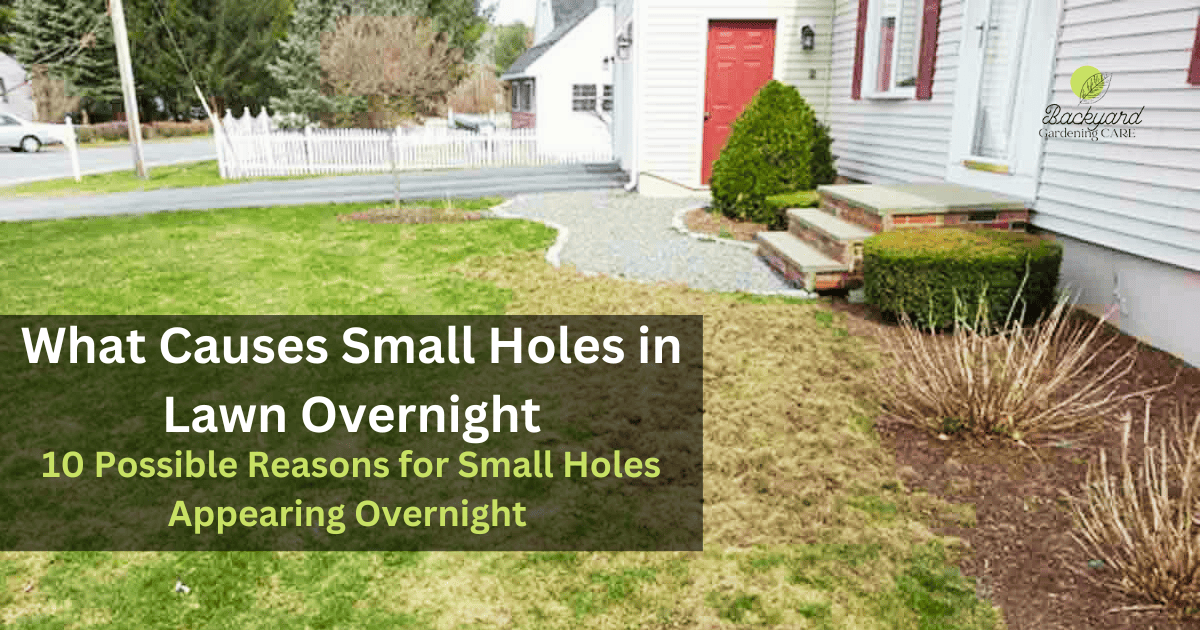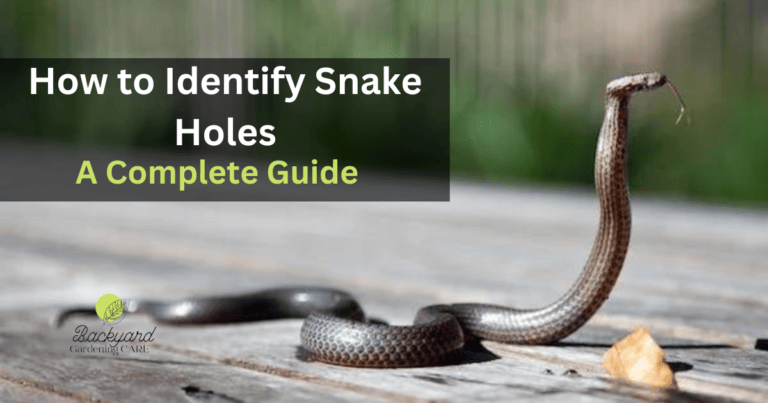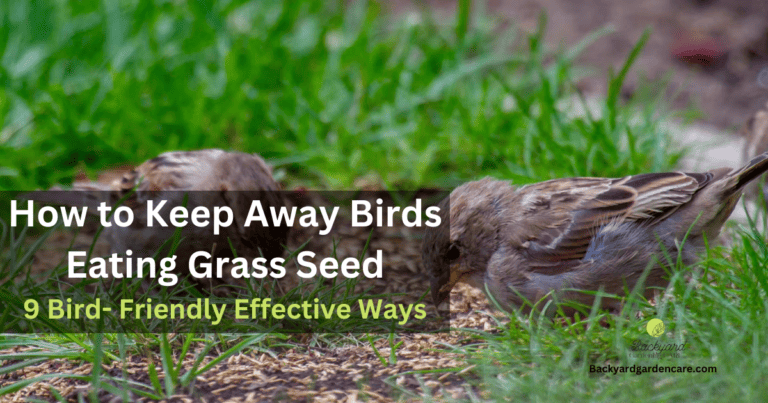Small Holes in Lawn Overnight, 10 Possible Reasons for Small Holes Appearing Overnight.
Small holes appearing in your lawn overnight can be quite a mystery. One day, your lawn is perfect and untouched; the next day, it seems like a group of tiny creatures has invaded it.
But what actually causes these small holes? Is it a result of pests, wildlife, or something else entirely? In this article, we will explore the common causes of small holes vs snake holes in lawns overnight and discuss effective strategies for preventing and addressing this issue.
Whether you are a homeowner or a professional gardener, understanding the causes of these holes is essential for maintaining a healthy and beautiful lawn.

Keep reading to find out what’s causing these small holes in lawn overnight.
Possible Reasons for Appearing Small Holes in Lawn Overnight
Small holes mysteriously appearing overnight can be a puzzling occurrence for homeowners. Discovering these tiny holes seemingly out of nowhere can be quite perplexing and even slightly alarming.
While it may seem a mystery, several possible reasons exist for these small holes. In this section, we will explore some of the most common causes and offer insights into how to identify and address them.

Listed below are some causes, but we will few causes discuss in detail.
- Gophers
- Insects
- Squirrels
- Moles
- Earthworms
- Chipmunks
- Insects
- Snakes
- Voles
- Armadillos
1. Gophers
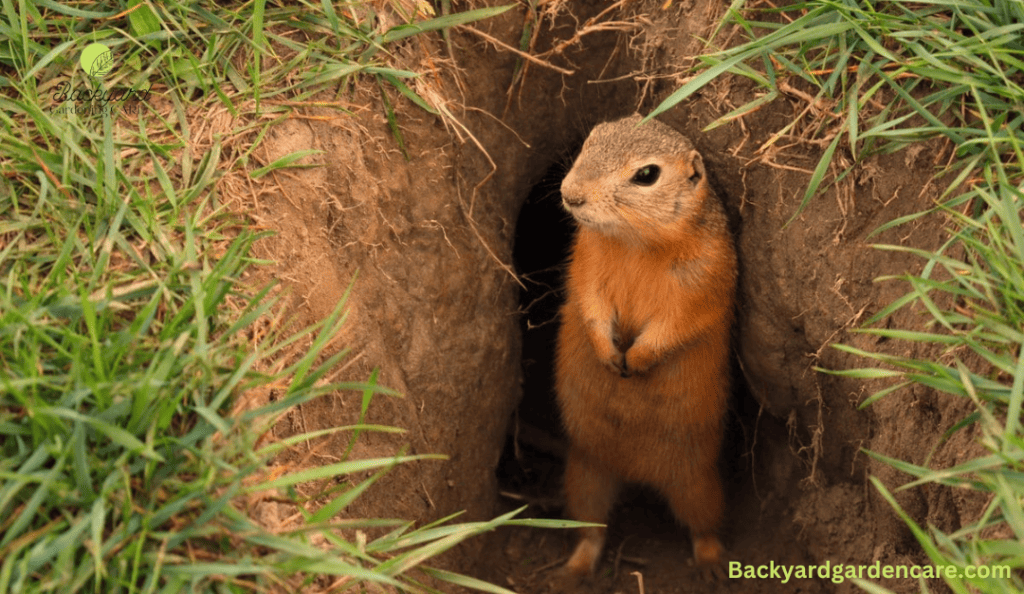
Gophers, those burrowing rodents known for their intricate tunnel systems, can be frustrating on your lawn. Their small holes appear overnight, accompanied by mounds of soil around the openings.
In this section, we will delve into the world of gophers, explore their behaviour, and provide effective solutions to address the issue.
Understanding Gophers
Scientifically called Geomyidae, gophers are commonly found in Northern and Central America. They possess a strong inclination towards digging and constructing intricate tunnel systems, complete with specialized holes for various functions.
These holes serve as both storage areas for their food and as a means of protection against predators, including humans. Spotting gopher holes is relatively effortless as they are accompanied by mounds of soil surrounding the entrances.
Gophers favour light and easily excavatable soil, making your lawn an appealing destination for their burrowing endeavours.
The Aggressive Nature of Gophers
Despite their small size, gophers are surprisingly aggressive. While they typically try to run away when confronted, they will not hesitate to fight back if they feel trapped or unable to escape.
It’s important to be cautious when dealing with gophers, especially if you have pets, as interactions with other animals can result in scrapes or injuries.
The Impact of Gophers on Lawns
Gophers, being herbivores, mainly consume grassroots. Their digging behaviour can result in substantial problems below the ground, causing harm to structures and ruining the appearance of the lawn.
While examining the tunnels, you may frequently come across chewed grass blades as remnants, indicating their preference for a vegetarian diet.
Effective Solutions for Dealing with Gophers
Addressing a gopher problem requires a proactive approach. Here are some solutions that can help deter gophers from your lawn.
Scare Tactics: Gophers are more likely to steer clear of areas where they sense the presence of predators. Utilize scare tactics such as placing used cat litter or dog droppings into the exposed gopher holes. The scent of potential predators may make them think twice before infiltrating your lawn.
Strong Odors: Gophers have an aversion to certain strong smells. Drop dryer sheets, mothballs, castor oil, or coffee grounds into the gopher holes to repel them. These scents can be natural deterrents and discourage gophers from making your lawn their home.
Natural Repellents: Consider using all-natural gopher repellents to discourage their presence. Plants like lanterns, daffodils, marigolds, or Euphorbia lathyris have effectively repelled gophers. Incorporating these plants into your garden can create a less attractive environment for gophers.
Professional Assistance: If the gopher problem persists or becomes unmanageable, seeking the help of a professional pest control service is a viable option. Pest control experts have the knowledge and tools to assess the situation and implement targeted gopher removal strategies accurately.
Using these solutions, including traps and chemical pest control, you can protect your lawn from the destructive burrowing habits of gophers. Remember to remain vigilant and take effective action to prevent further damage to your outdoor space
2. Armadillos
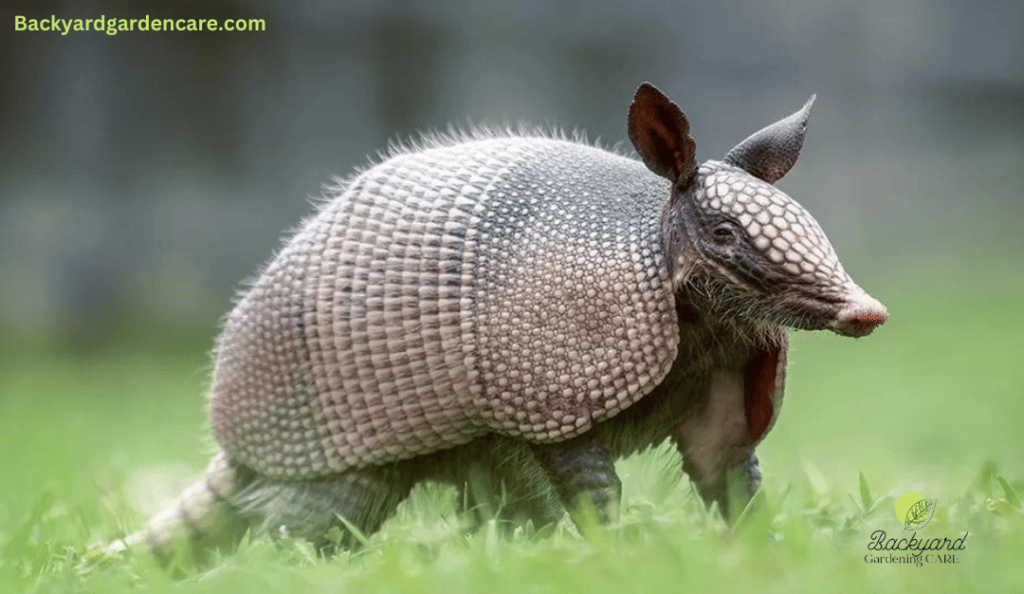
Drawing from personal experience as a resident of the Southern United States, I’ve often encountered armadillos and witnessed the aftermath of their nocturnal digging. Armadillos are indeed fascinating creatures native to the region, and their burrowing habits are quite common. They dig these holes primarily to find insects, which make up a significant part of their diet.
Additionally, I’ve sought out a second opinion from a local wildlife expert. According to them, armadillos are notorious for creating these overnight holes, and understanding their behaviour is crucial to tackling the issue effectively. In this article, I will delve into armadillo behaviour, shed light on the reasons behind their digging, and provide practical solutions to address the presence of these holes in your yard.
Understanding Armadillos
Scientifically known as Cingulata, armadillos inhabit various regions, ranging from as far north as Nebraska and Indiana in North America to as far south as Argentina in South America.
A large part of their diet consists of insects, so they evolved powerful claws for digging dens and unearthing them.
Burrowing Behavior and Hole Sizes
Armadillos create burrows to build dens and search for food. The size of the burrow and holes varies based on the armadillo species and individual.
The nine-banded armadillo, for example, typically digs burrows that are no wider than 8 inches but can extend up to an impressive 25 feet in length. Armadillos prefer moist soil for constructing their burrows.
This type of soil makes digging easier and attracts insects that thrive in wet environments. Armadillos dig holes mainly to feed on subterranean creatures like ants and grubs.
Effective Solutions for Armadillo Holes
To address the issue of armadillo holes in your lawn, it is essential to focus on eliminating their food sources and implementing prevention measures. Here are some effective solutions to consider:
Removing Food Sources: Armadillos are attracted to areas abundant in insects. By reducing the insect population in your lawn, you can make it less appealing to armadillos.
Consider using grub killer products specifically designed to target and eliminate grubs, a preferred food source for armadillos. Treating your yard for ants or other insects can help reduce the armadillo’s food supply.
Scented Deterrents: Armadillos have a sensitive sense of smell. If you use scented deterrents on your property, you can find that they will be less likely to enter it.
Spraying hot sauce or other strong-smelling substances near their burrows or around your lawn may deter armadillos from digging new holes or revisiting existing ones.
Professional Assistance: If the armadillo problem persists or becomes unmanageable, seeking assistance from wildlife control professionals may be necessary. Their expertise and tools make it safe and effective for them to remove armadillos from your property.
Using these solutions, you can minimize the presence of armadillos and reduce the likelihood of new holes appearing overnight in your lawn. It is important to remain persistent and consistent in your efforts to deter these persistent diggers.
3. Squirrels

Squirrels, members of the Sciuridae family, are known for their nesting behaviours and ability to dig small holes in lawns.
While there are different types of squirrels, including tree squirrels, ground squirrels, and flying squirrels, ground squirrels pose the main concern when it comes to lawn damage.
Here, we will explore the behaviour of ground squirrels and the reasons and provide effective solutions to address the issue.
Understanding Ground Squirrels
Ground squirrels are notorious for constructing intricate burrows with multiple tunnels and entrances. These burrows frequently contain numerous entry points that are closely grouped, leading to considerable annoyance for homeowners.
While other squirrel species may inflict less harm on lawns, ground squirrels pose a particularly troublesome issue.
Characteristics of Squirrel Holes
Squirrel holes are typically located in mulchy areas or garden beds and are usually dug very slowly into the soil.
These holes are about 4 inches in diameter and are commonly seen on sloped ground, allowing squirrels to have better visibility and reducing the chances of flooding in their burrows.
The small depressions made by squirrel holes can collect water, resulting in puddles. These puddles can harm small plants, potentially causing damage or even death.
Effective Solutions for Squirrel Holes
To address the small holes created by ground squirrels in your lawn, it is important to take proactive measures to deter them. Here are some effective solutions to consider:
Getting a Dog: Squirrels are naturally wary of predators, and the presence of a dog in your yard can help deter them. A dog’s sight, sound, and scent can make squirrels think twice before venturing into your lawn.
Sound Machine: Using a sound machine that emits high-frequency sounds or predator calls can help repel squirrels and keep the birds away from grass seeds. These devices create an environment that is unfavourable for squirrels, encouraging them to stay away from your lawn.
Fox Scent: Spraying fox scent in the area can mimic the presence of a natural predator, deterring squirrels from approaching. You can find fox scent products specifically designed for this purpose at garden centers or online.
Garlic Spray: Squirrels dislike the strong scent of garlic. Spraying a garlic-infused solution around your lawn can be a natural deterrent, making the area less appealing to squirrels.
Fake Predator Decoy: Placing a fake predator decoy, such as a plastic owl or hawk, in your yard can create the illusion of a potential threat to squirrels. It is possible to discourage squirrels from approaching by placing these decoys, thereby preventing the creation of new holes overnight.
By using these solutions, you can minimize the presence of ground squirrels and prevent new holes from forming in your lawn. It is important to note that consistency is key, as squirrels can adapt quickly to certain deterrents. Combining or rotating different methods can increase their effectiveness.
4. Ground Moles

Ground Moles, belonging to the Talpidae family, are small animals that dig holes in the ground and are known for their underground burrowing habits. These elusive creatures can create numerous small holes in lawns overnight, causing frustration for homeowners. Here, we will explore the behaviour of ground moles and provide effective solutions to get rid of ground moles to address the issue.
Understanding Moles
Moles can be easily identified by the noticeable heaps of earth surrounding their burrows. In a small yard, a single mole can produce numerous exit holes, causing significant problems for lawns.
These cunning creatures can dig several small holes, each measuring two inches, in a short time and conceal them by the next morning.
Identifying Mole Holes
Mole holes are characterized by the presence of conical mounds of dirt above the ground. These mounds indicate the presence of moles and affect the look of a well-maintained lawn.
Along with these visible holes, moles construct extensive tunnels beneath the ground. They navigate underground to find grubs and other insects, their main food source.
Effective Solutions for Mole Holes
Dealing with mole holes requires a strategic approach. Here are some effective solutions to consider:
Buying Grub Killer: Moles are attracted to lawns that have plenty of grubs and insects in the soil. It is possible to eliminate the moles’ food source and make your lawn less attractive to them by using a grub killer product designed to eliminate these pests.
Consult with a garden center or professional to choose the appropriate grub killer for your specific needs.
Improving Lawn Drainage: Moles are more likely to be attracted to lawns with moist soil. Improving the drainage system can also be helpful to stop unwanted pests and bugs in your lawn. This helps dry out the soil and makes it less suitable for moles to burrow. Ensure that your lawn has proper irrigation and drainage systems in place to prevent excessive moisture buildup.
Professional Assistance: If the mole problem persists or becomes unmanageable, seeking help from a professional pest control service may be necessary. Pest control experts have the knowledge and tools to assess the situation and implement targeted mole removal strategies accurately.
By using these solutions, you can minimize the presence of moles and prevent new holes from appearing overnight in your lawn. It’s important to note that moles can be persistent, so consistency in applying these methods is key to achieving long-term success.
In short, moles can be a nuisance when they create small lawn holes overnight. Understanding their behaviour, removing their food sources, and employing effective deterrents will help protect the integrity of your lawn.
5. Insects
Insects belonging to the class Insecta comprise an astonishing array of over 6 million species worldwide. With such a vast variety of insects, it can be challenging to pinpoint the exact species responsible for digging small holes in your lawn overnight.
However, among insects, bees are often the culprits behind these tiny excavations. In this section, we will explore the behaviour of bees and provide effective solutions to address the issue.
Understanding Bees and Hibernation
During certain periods of their life cycle, bees create small holes in lawns. This is especially common when they are hibernating underground during the winter months.
By doing so, they protect themselves from the cold and ensure their survival. When spring arrives, these bees emerge from their hibernation sites, leaving holes in the ground as they surface.
The Role of Bees in Hole Creation
Bees typically create holes when they come out of the ground after hibernation. However, certain bee species may also dig or burrow holes as part of their natural behaviour. The size and depth of these holes can vary depending on the species and their breeding needs.
Not all bees engage in burrowing behaviour, so the presence of holes in your lawn might indicate a specific species or nesting activity.
Effective Solutions for Bee-Related Holes
It is essential to employ effective and environmentally friendly solutions to address the issue of small holes caused by bees in your lawn. Here are some recommended approaches.
Applying Insect Repellent: Using insect repellents formulated for outdoor use can help deter bees from your lawn. Choose a repellent specifically designed for bees and follow the instructions carefully to ensure safe and effective application.
Planting Bee-Repellent Foliage: Certain plants, bushes, and shrubs have properties that naturally repel bees. Consider incorporating bee-repellent foliage into your garden or lawn area.
Examples include marigolds, eucalyptus, citronella, Mint, and basil. These plants can act as natural deterrents, reducing the likelihood of bees creating new holes.
Spraying Almond Oil or Pyrethrum Spray: Almond oil and Pyrethrum spray are commonly used organic insecticides that can help repel bees.
These substances can be sprayed on areas prone to bee activity, acting as deterrents without causing harm to the bees or the environment. Be sure always to follow the instructions on the product and be cautious when applying any type of pesticide.
It is important to note that bees play a crucial role in pollination and the overall health of ecosystems. Therefore, exploring non-lethal and environmentally friendly methods to address bee-related holes in your lawn is recommended.
Furthermore, bees are often responsible for small holes in lawns, primarily when emerging from hibernation or engaging in nesting behaviours.
Understanding their behaviour and employing suitable solutions will help maintain a balance between addressing the issue and preserving bees’ essential role in our ecosystem.
Conclusion
The presence of small holes in the lawn overnight can be attributed to various factors. It is important to accurately identify the cause to implement the appropriate solution.
It is very important to understand the underlying cause of the problem, whether it is caused by burrowing animals, such as moles and voles, or by insects, such as ground-dwelling bees and ants, or by small holes in yard after rain.
Understanding the underlying cause is extremely important. Once identified, homeowners can take the necessary steps to mitigate the issue, such as implementing pest control measures or creating barriers to deter animals. Regular lawn maintenance, including proper watering and fertilization, can also help prevent the occurrence of small holes in the lawn.
FAQs
What Animal Digs Small Holes in Lawn at Night?
The animals that commonly dig small holes in lawns at night is usually the nocturnal creature known as common mole and Voles.
Why Are There Random Holes in My Lawn?
Random holes in your lawn can have several possible causes. One common reason is the presence of burrowing animals such as moles, voles, Insects, Squirrels, or gophers. These creatures dig tunnels and create holes to search for food or establish their nests.
Another possible cause could be extreme weather conditions, such as heavy rain or frost, which can cause soil displacement and create random holes in your lawn.
What Makes 3 Inch Holes in the Ground?
There are a few possible explanations for 3-inch holes in the ground. One possibility is that burrowing animals, such as moles, ground squirrels, or pocket gophers, cause them.
These animals create tunnels and burrows underground, which can result in small holes in the surface. Another potential cause could be the activity of insects, such as ants which may dig holes for nesting purposes.
What Animal Makes a Small Hole in the Ground?
The animal that commonly makes small holes in the ground is the burrowing animal. Some examples of burrowing animals include ground squirrels, Voles, and moles. These animals dig tunnels and create small holes to construct their underground homes.
Albert Phipps

Hello, I’m Albert Phipps, your trusted professional gardener. I have a deep passion for nurturing nature’s beauty, With years of experience in landscaping. I’m dedicated to creating lush, vibrant gardens and outdoor spaces.
If you’re seeking guidance on plant selection, grass care, pest control products, garden design, or lawn maintenance tips, don’t hesitate to get in touch. I’m here to help you transform your outdoor space into a thriving and serene landscape.

